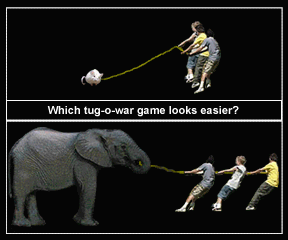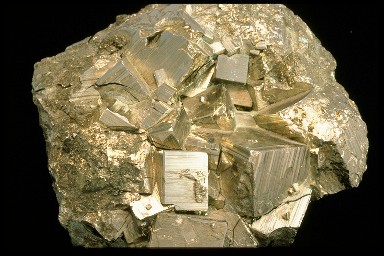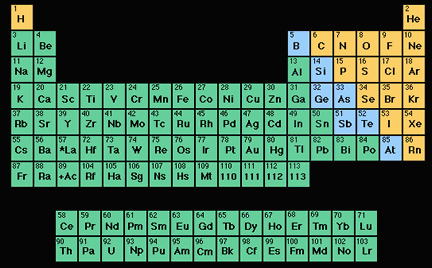The periodic table of the elements, one way to describe the properties of matter.
Click on image for full size
L.Gardiner/Windows to the Universe
Starting Points for Science
Some ideas are used in many, many places throughout science. We have grouped these "starting points for science"
into three clusters: space, time, and matter.
"Space" is the word we use for everything beyond Earth. However,
"space" is also the way we refer to location and the distance
between objects. We live in a world with three dimensions, so coordinate systems that describe locations and distances
are an important tool for describing space. The many units we use for measuring
distance are an important part of our notion of space. Our modern view of the
Universe, based on Einstein's General Theory of Relativity, includes the
idea that space is curved.
Time is a second key idea. Many of our measures of time, such as days, months, and years,
are based on astronomical phenomena. Armed with the concepts of space
and time, we can specify the "where" and the "when" in our observations of
the
world
around us.
Out third cornerstone concept is matter, the "stuff" without which
the Universe would be a lonely place. We specify the amount of matter in an
object in terms
of the object's mass. There are four basic forms that matter can take on: solid, liquid, gas or plasma. Matter can
be classified and grouped, as is done with the chemical elements in the periodic
table. Matter and energy can be transformed into one another, as expressed
in Einstein's famous equation relating the two: E = mc2.
You might also be interested in:

Would it be more difficult to pull an elephant or a mouse? If you pulled each animal with the same amount of force, the elephant would respond less to pulling, even if he didnít pull back at all. Thatís
...more
Solid is one of the four common states of matter. The three others are gas, liquid, and plasma. There are also some other exotic states of matter that have been discovered in recent years. Unlike liquids
...more
Plasma is known as the fourth state of matter. The other three states are solid, liquid and gas.In most cases, matter on Earth has electrons that orbit around the atom's nucleus. The negatively charged
...more
An element (also called a "chemical element") is a substance made up entirely of atoms having the same atomic number; that is, all of the atoms have the same number of protons. Hydrogen, helium, oxygen,
...more
Everything you see around you is made of tiny particles called atoms. There are many different types of atoms, each with a special combination of protons , neutrons and electrons . These different types
...more
Some ideas are used throughout the sciences. They are "tools" that can help us solve puzzles in different fields of science. These "tools" include units of measurement, mathematical formulas, and graphs.
...more
Some ideas are used in many, many places throughout science. We have grouped these "starting points for science" into three clusters: space, time, and matter. "Space" is the word we use for everything
...more












